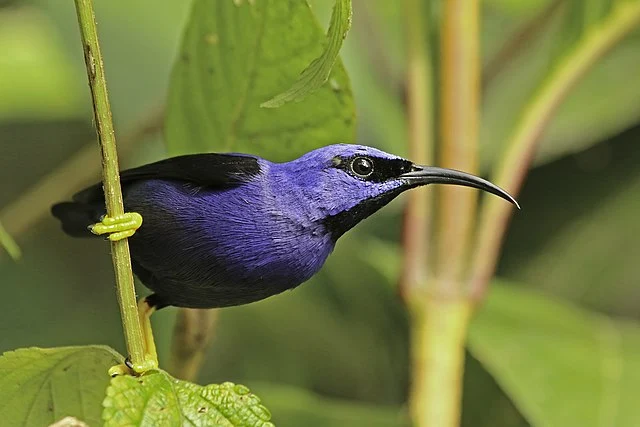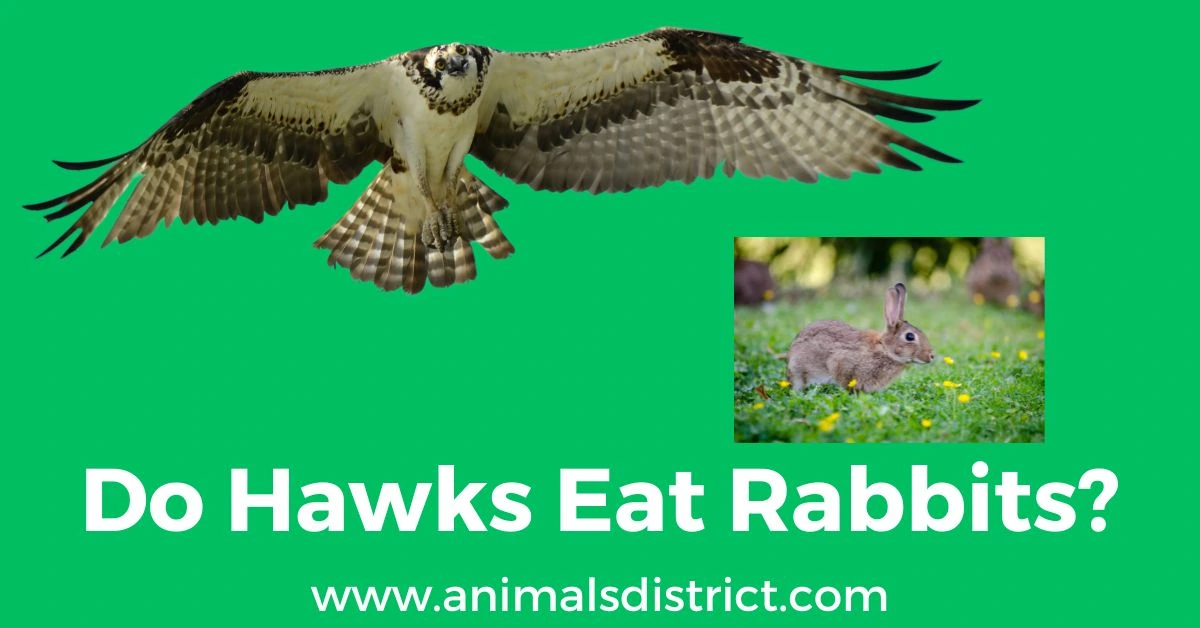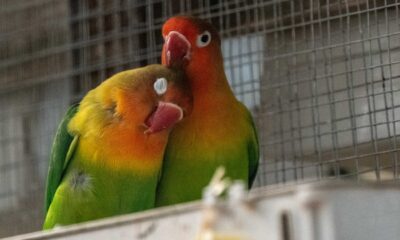Birds
5 most purple birds in the world – PICTURES & VIDEOS 2023

Last Updated on August 9, 2023 by israel olaniran
Purple might seem like a weird color to see on birds, definitely, not everyone has had the opportunity to see a purple bird physically and many still doubt their existence, in this blog post I would be showing you some of the world’s most purple-colored birds in the worlds and I would be telling you a brief history about each of them, let’s get started.
It is important to know that many of these birds might not be purple colored in every part of their body but they do have a significantly large amount of purple on them
Top 5 most purple birds in the world
This list isn’t arranged in any special order, just my level of interest
1. Violet-backed Starling
In the heart of tropical Africa, the Violet-backed Starling (Cinnyricinclus leucogaster) graces the landscape with its iridescent plumage. This avian gem showcases a stunning contrast between its violet back and a pure white underbelly. As it flits through the lush foliage, the sunlight dances on its feathers, creating a mesmerizing spectacle.
The violet-backed starling, also known as the plum-coloured starling or amethyst starling, is a relatively small species of starling in the family Sturnidae. It is the only member of the genus Cinnyricinclus.
Wikipedia


Here’s what I found out about this beautiful bird:
- Native Country: South Africa
- Length: 18cm
- kingdom: Animalia
- Phylum: Chordata
- Class: Aves
- Order: Passeriformes
- Family: Sturnidae
- Species: Cinnyricinclus leucogaster
They are the smallest of the South African starlings, the males and the females have different colors, it would interest you to know that their males have bright purple-violet colors with black wings, face, and throat, while the females on the other hand are mostly brown in color.
They are omnivorous in nature and they feed on fruits, insects, and figs. They love insects like termites, wasps, bees,u and locusts. The females lay on their eggs for a period of 10-14 days while both parents provide food for the younger ones when they hatch.
what does snake poop look like?
🐾 Are you a dog owner who wants to ensure your dog gets the absolute best in terms of nutrition?
2. Purple Starling
Hailing from the Indian subcontinent, the Purple Starling (Cinnyricinclus leucogaster) is a testament to the symphony of nature. Its purple-tinged feathers shimmer in the sunlight, captivating the beholder. What sets this bird apart is not just its appearance but also its melodious songs that fill the air with an enchanting cadence.
The purple starling, also known as the purple glossy starling, is a member of the starling family of birds. its binomial name is Lamprotornis purpureus
wikipedia

Here’s what I found out about this beautiful bird:
- Native Country: Senegal, north Zaire, Sudan, and Kenya
- Length: 22-23 cm
- kingdom: Animalia
- Phylum: Chordata
- Class: Aves
- Order: Passeriformes
- Family: Sturnidae
- Species: L. purpureus
They have yellow eyes with metallic purple-colored heads and bodies with glossy green-colored wings, they are omnivorous and they feed on insects and fruits
What happens if cats are left in a dark house?
3. Purple Honeycreeper
Venture into the rainforests of Central and South America, and you might be lucky enough to spot the Purple Honeycreeper (Cyanerpes caeruleus). This small jewel of a bird boasts a vibrant purple-blue hue that seems to have been painted by nature’s own brush. Its delicate frame and striking color make it a true work of art in flight.
The purple honeycreeper is a small Neotropical bird in the tanager family Thraupidae. It is found in the tropical New World from Colombia and Venezuela south to Brazil, and on Trinidad. A few, possibly introduced birds have been recorded on Tobago.
wikipedia


Here’s what I found out about this beautiful bird:
Native Country: northern South America
Length: 11.5 cm
kingdom: Animalia
Phylum: Chordata
Class: Aves
Order: Passeriformes
Family: Thraupidae
Species: C. caeruleus
The males of these beautiful birds are purple in color with black wings, belles, and tails, with nice-looking yellow feet, the females have green-colored body parts, and the sound of a purple honeycreeper sounds like a high-pitched zree.
They feed on nectar berries and seeds majorly they are usually found in small groups.
Are cats stronger than dogs pound for pound?
4. Purple Martin
Graceful and charming, the Purple Martin (Progne subis) is a native of North America and a cherished sight among bird enthusiasts. With its deep purple plumage and sleek aerial acrobatics, this bird graces the skies in search of insects. Its presence is a reminder of the delicate balance of our ecosystems.
The purple martin is a passerine bird in the swallow family Hirundinidae. It is the largest swallow in North America. Despite its name, the purple martin is not truly purple.
wikipedia


Here’s what I found out about this beautiful bird:
Native Country: North America,
Length: 19–20 cm
kingdom: Animalia
Phylum: Chordata
Class: Aves
Order: Passeriformes
Family: Hirundinidae
Species: P. subis
Their males are black in color with a glossy steel blue sheen, both genders suffer from delayed plumage maturation.
They are insectivorous, they feed majorly on insects and her known to be good hunters.
They breed in colonies close to humans.
Read about the Russian german shepherd here
5. Varied Bunting
The Varied Bunting (Passerina versicolor) of North America is a living testament to the wonders of biodiversity. The males proudly flaunt their vibrant plumage, showcasing hues of purple, blue, and red. Their presence adds a burst of color to arid landscapes and serves as a reminder of the intricate tapestry of life.
The varied bunting is a species of songbird in the cardinal family, Cardinalidae. The range of the varied bunting stretches from the southern parts of Arizona, New Mexico, and Texas in the United States south throughout Mexico as far as Oaxaca.
wikipedia

Native Country: the United States, Mexico
Length: 11–14 cm
kingdom: Animalia
Phylum: Chordata
Class: Aves
Order: Passeriformes
Family: Cardinalidae
Species: P. versicolor
They have short tails and rounded bills, males are purple read in color with a bright red patch on their nape while on the females are brown
What does snake poop look like? read here
What Makes These Birds Purple?
The enchanting purple coloration of these birds is not just for show; it serves a vital purpose in their lives. The plumage plays a role in mate attraction, signaling health and genetic fitness. The structural arrangement of feather cells creates interference patterns that result in the vivid display of color we see.
The Role of Plumage Color in Bird Behavior
Beyond aesthetics, plumage color influences bird behavior and interactions. It can indicate dominance, hierarchy, and territorial boundaries. The purple plumage may hold the key to understanding complex social dynamics and survival strategies within avian communities.
Conservation Efforts for Purple Birds
Unfortunately, many of these purple bird species face threats due to habitat loss and human activities. Conservation efforts play a crucial role in preserving their natural habitats and ensuring their survival for generations to come. By supporting organizations dedicated to bird conservation, we can contribute to the protection of these mesmerizing creatures.
Purple Birds in Culture and Mythology
Throughout history, purple has been associated with royalty, spirituality, and mystery. It’s no wonder that these birds have captured human imagination and have become symbols in various cultures and mythologies. Their presence in folklore and art highlights the profound impact of nature on human creativity.
Capturing the Essence: Photographing Purple Avian Wonders
For photographers and bird enthusiasts alike, capturing the ethereal beauty of purple birds can be a rewarding challenge. Patience, the right equipment, and an understanding of bird behavior are essential for creating stunning images that showcase these avian marvels in all their purple glory.
Observing Purple Birds in the Wild: Tips for Birdwatchers
If you’re an avid birdwatcher, encountering these purple birds in their natural habitats can be a remarkable experience. Equip yourself with binoculars, field guides, and a spirit of adventure. Research their preferred locations and behaviors to increase your chances of witnessing these avian wonders up close.
Are purple birds truly purple?
Yes, their plumage displays shades of purple that can range from deep violet to lavender, often depending on the angle of light.
Are purple birds endangered?
Some species, such as the Purple Martin, have stable populations, while others, like the Purple Honeycreeper, may face threats due to habitat loss.
Final Thoughts On Top 5 most purple birds in the world
The world of birds never ceases to amaze us with its breathtaking diversity and beauty. The top 5 most stunning purple birds we’ve explored – the Violet-backed Starling, Purple Starling, Purple Honeycreeper, Purple Martin, and Varied Bunting – serve as a testament to the wonder and splendor of nature’s creations. Their vibrant plumage, unique behaviors, and cultural significance remind us of the intricate tapestry of life on Earth.

Birds
Do Hawks Eat Rabbits? ALL You Need To Know (2023)

Last Updated on July 30, 2023 by israel olaniran
Hawks, the majestic birds of prey, have long captured the fascination of both nature enthusiasts and birdwatchers alike. With their keen eyesight and incredible hunting abilities, they play a vital role in the ecosystem as top-level predators. One question that often arises in discussions about hawks is, “Do hawks eat rabbits?” In this article, we will delve into the intriguing relationship between hawks and rabbits, exploring the dynamics of their interactions in the wild and the significance of their coexistence.
Read: do hawks eat snakes?
Do Hawks Eat Rabbits?
Yes, hawks do eat rabbits. Hawks are formidable birds of prey with keen hunting abilities, and rabbits are among their favored prey. Hawks rely on their sharp vision and aerial prowess to spot, pursue, and capture rabbits, making them an essential part of the predator-prey dynamics in the natural world.
The relationship between hawks and rabbits highlights the delicate balance and ecological significance of such interactions in maintaining healthy ecosystems.

Hawks: Characteristics and Habits
Hawks are raptors belonging to the family Accipitridae. These birds are renowned for their sharp vision, powerful talons, and hooked beaks that enable them to be highly efficient hunters. Hawks exhibit a wide range of sizes and appearances, from the small and agile Sharp-shinned Hawk to the majestic and formidable Red-tailed Hawk. Their hunting behavior is characterized by swift and precise movements as they target their prey from elevated vantage points.
Read: what animals eat hawks?
Rabbits: An Easy Prey
Rabbits, on the other hand, belong to the family Leporidae and are known for their rapid reproductive abilities. They are small herbivorous mammals that inhabit various habitats, from forests to grasslands. Rabbits reproduce quickly, and their population can grow exponentially under favorable conditions. However, they are also vulnerable to predation due to their relatively small size and lack of substantial defensive mechanisms.
Read: how much weight can a hawk carry?
Hawk and Rabbit Interaction in the Wild
The encounter between a hawk and a rabbit in the wild is a testament to the predator-prey relationship. Hawks are equipped with exceptional eyesight that allows them to spot potential prey from great distances. Once a hawk identifies a rabbit as a target, it employs various techniques to capture its meal. The element of surprise is crucial in a successful hunt, and hawks are known for their swift and stealthy approaches when diving towards their unsuspecting prey.
🐾 Are you a dog owner who wants to ensure your dog gets the absolute best in terms of nutrition?
Read: All you need to know about rabbit poop?
Impact of Hawks on Rabbit Population
As apex predators, hawks play a significant role in maintaining the balance of the ecosystem. By preying on rabbits and other small mammals, they help control the population of these species, preventing overpopulation and its subsequent effects on vegetation and other animals. While hawk predation may cause a decline in the rabbit population in certain regions, it ultimately benefits the overall health of the ecosystem.
Coexistence and Survival Strategies
Over time, rabbits have developed various survival strategies to cope with the constant threat of hawk predation. Their keen sense of hearing and speed enable them to detect the approach of hawks and other predators. In addition, rabbits often seek shelter in burrows or dense vegetation to evade capture. Despite being a potential food source for hawks, rabbits’ ability to reproduce rapidly and adapt to their environment helps maintain a healthy prey population for hawks and other predators.
Human Impact and Conservation Efforts
Human intervention can significantly affect the dynamics between hawks and rabbits. Habitat loss and environmental degradation may disrupt the natural balance, leading to population imbalances in both species. Conservation efforts that focus on preserving natural habitats and protecting endangered species are vital in maintaining the delicate ecological relationships between predators like hawks and their prey.
Understanding the Food Chain
The hawk-rabbit interaction highlights the concept of the food chain and trophic levels in an ecosystem. Hawks, as apex predators, occupy the highest trophic level, while rabbits are primary consumers at a lower trophic level. The interdependence of these levels ensures the stability and functioning of the entire ecosystem.
Fascinating Facts about Hawks and Rabbits
Before concluding, let’s explore some interesting trivia about hawks and rabbits. Did you know that some hawks are migratory, covering thousands of miles during their seasonal movements? On the other hand, rabbits are known for their remarkable agility, capable of reaching speeds of up to 35 miles per hour to escape predators.
Final Thoughts On Do Hawks Eat Rabbits?
In conclusion, the question “Do hawks eat rabbits?” reveals a captivating tale of predator-prey dynamics in the natural world. Hawks, with their prowess and precision, contribute to the ecological balance by controlling rabbit populations and other small mammals. At the same time, rabbits’ adaptability and reproductive abilities enable them to coexist with their aerial predators. Understanding and appreciating these complex relationships are crucial for promoting conservation efforts and safeguarding the delicate harmony of our ecosystems.
Are all hawks carnivorous?
While the majority of hawks are carnivorous and primarily feed on small mammals and birds, some hawks have adapted to consume a more varied diet, including insects and reptiles.
Do hawks only eat live prey?
Hawks are indeed carnivores and primarily hunt live prey. However, they may occasionally scavenge on carrion when live prey is scarce.
Can rabbits defend themselves from hawks?
Rabbits rely on their agility and evasive skills to avoid predation. While they can’t physically defend themselves against hawks, their speed and ability to take cover serve as their primary defense mechanisms.
How fast can a hawk swoop down to catch a rabbit?
Hawks are incredibly fast and can reach speeds of up to 120 miles per hour during their dives or swoops to catch prey
What is the lifespan of hawks and rabbits?
The lifespan of hawks and rabbits can vary depending on the species and their living conditions. Hawks generally live around 10 to 20 years, while rabbits in the wild have an average lifespan of about 1 to 2 years due to various predators and environmental factors.
Do eagles eat rabbits?
Yes, eagles are also birds of prey, and like hawks, they have a carnivorous diet that includes rabbits and other small mammals as part of their pr
What animal eats rabbits?
Several predators eat rabbits, including hawks, eagles, owls, foxes, coyotes, bobcats, and even larger snakes and some species of weasels.
Can snakes eat rabbits?
yes, some larger snake species, such as certain constrictors, can consume rabbits as part of their diet.
How do hawks kill rabbits?
Hawks use their sharp talons to grasp and immobilize their prey, including rabbits. They may deliver a swift strike from the air or pounce on rabbits from elevated perches.
Do hawks eat snakes?
Yes, some hawk species do eat snakes. Snakes are another prey item for certain types of hawks.
Do hawks eat birds?
Yes, birds are a common part of a hawk’s diet. Hawks are skilled hunters and can catch other birds during flight.
Do hawks eat grasshoppers?
While hawks primarily prey on small mammals and birds, they may also consume insects like grasshoppers occasionally, especially during times of food scarcity.
Do hawks eat squirrels?
Yes, squirrels are a part of a hawk’s diet, and some hawk species are adept at catching squirrels in trees and on the ground.
Do hawks eat small dogs?
While it is rare, some large hawk species could potentially target small dogs as prey, though it is not a common occurrence. Small dogs are generally not a primary target for hawks.
-
Domestic Animals2 years ago
Why Do Dogs Look Away When You Eat
-
Domestic Animals6 months ago
Small But Smart: 10 Most Intelligent Small Dog Breeds
-
Wild Animals2 years ago
What Does Snake Poop Look Like? PICTURES & VIDEOS
-
Pet News6 months ago
Trending Now: Woman Raised A Panther Thinking It Was A Cat.
-
Domestic Animals8 months ago
Why Does My Cat Sleep On My Feet? Best Reasons
-
Insects7 months ago
Australian Stick Bug: ALL You Need To Know.
-
Domestic Animals1 year ago
Can Guinea Pigs Eat Oranges? ALL You Need To Know!
-
Domestic Animals2 years ago
Can Guinea Pigs Eat Pears? All You Need To Know (2023)




















